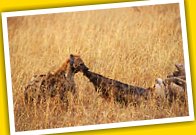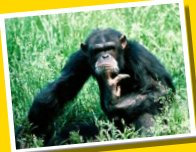Tanzania National Parks, Game Reserves and wildlife conservation areas
|

|
Tarangire National Park
With an area of 2600 sq.km, this is one of the most beautiful protected aeas in northern Tanzania. It has the highest concentration of wildlife during the dry season, and is the only park in the area where one can find a large concentration of elephants year round. Tarangire is known for its river floodplains, wetlands, gently rolling hills, rocky outcrops, acacia woodlands and numerous baobab trees. The park is also home to oryx, greater and lesser kudu, lion, cheetah, generuk, wildebeest, zebra and more than 550 species of birds.
|
|
Ruaha National Park
Ruaha National Park is the second largest park in Tanzania (12950 sq.km). Together with Rungwe/Kizigo Game Reserve it forms the large Ruaha Ecosystem. The great Ruaha River flows through the entire eastern part of the park and it is the centre of wildlife activities during the dry months of June to November. The park has the second largest elephant population in the country. Other animals include wild dogs, greater and lesser kudu, sable and roan antelope, hippo, lion, leopard, cheetah and over 400 species of migrant and resident birds.
|

|
|

|
Mikumi National Park
Mikumi National Park is the third largest park in Tanzania (3230 sq.km). The main feature is the flood plain of Mkata River, together with the Uluguru mountain ranges which border the park on two sides. The flood plain are largely open grassland and is bordered in the west and east by wooded grassland and intermediate vegetational zones which merge with miombo woodland. Animals include elephants, giraffes and lions.
|
|
Selous Game Reserve
Is the largest game reserve in Africa (second largest in the world). Selous holds large numbers of wildlife, most of it along the mighty Rufiji River. Due to seasonal flooding, it has created along its course many permanent lakes which are centres of wildlife activity. In addition to a large population of elephants, there are buffalo, wildebeest, zebra, waterbuck, eland, lion, leopard, wild dogs, hippo, crocodiles, etc., and over 350 species of water and land birds. Only in Selous one can experience the thrill of a walking safari, which assures close contact with wildlife.
|

|
|

|
Serengeti National Park
This most famous game park in the world encompasses nearly 15,000 sq.kms and is unrivaled anywhere for its seasonally shifting concentrations of herbivores. Nearly 1.5 million wildebeest, 500,000 gazelle and 250,000 zebra completes a cyclical annual migration within the ecosystem between November and June. The Serengeti is also known for its large prides of lion, cheetah, wild dogs and leopard.
|
|
Lake Manyara National Park
Although one of the smaller Tanzanian parks (325 sq.kms) in the Rift Valley, Manyara boasts a large lake. During the months of July through April, the lake waters are tinged pink from the hundreds of greater and lesser flamingos who feed there. Other features of the park include its stable heards of elephants and buffalos, enormous troops of baboons and its famous tree-climbing lions.
|

|
|

|
Ngorongoro Conservation Area
Encompassing some 8300 sq.kms, this unique multiple land use area must be seen to be believed. The crater (a collapsed volcanic caldera) covers 250 sq.kms and is 611m deep. The crater floor contains alkaline and fresh water lakes and teems with large carnivores, herbivores, primates and birds. It also boasts one of the last viable populations of the nearly extinct black rhinoceros and the highest density of lions and spotted hyenas. A visit to the Ngorongoro Crater is like returning to prehistoric times when animals ruled the earth. Ngorongoro includes the world-famous archeological sites of Laetoli, with its fossil footprints of ancestral humans who walked the earth 3.6 million years ago, and Olduvai Gorge, which continues to yield a remarkable record of human evolution beginning some 2 million years ago.
|
|
Arusha National Park
Arusha National Park covers an area of about 137 sq.kms and is located near Arusha town between the peaks of Mt. Kilimanjaro and Mt. Meru. The Ngurdoto Crater, Momella Lakes, the highland mountain forest and the rugged Mt. Meru (4575m) are the four features of the park. There is a wealth of wildlife including the colobus monkeys, velvet monkeys, bushbucks, buffalos, red forest duikers, elephants and giraffes. More than 500 species of birds have been recorded.
|

|
|

|
Gombe National Park
This reserve is about 16 kms from Kigoma and can only be reached by boat from there. The main purpose of the park is research rather than tourism and the facilities there are minimal.The major attraction of the park are the chimpanzees that were made famous by Jane Goodall. In 1960 she set up the area as a chimpanzee research station. She wrote a book on the findings of her research called "In the shadow of man".This attracted much publicity to the Reserve and in 1968 the Gombe Stream National Park was established. It covers an area of 52 sq kms making it the smallest park of Tanzania. It is made up of a narrow, mountainous strip of land about 16 km long and 5 km wide that borders lake Tanganyika. The mountains, which rise steeply from the lake, are intersected by steep valleys which have streams running in them and are covered in thick gallery forest. The park head- quarters is located at Kasekela. The park can be visited all the year around.
|
|
Mahale National Park
This reserve, like Gombe Stream NP, is mainly a chimpanzee sanctuary but you won't find it marked on many maps since it was only created in 1985. It's on the knuckleshaped area of land which protrudes into Lake Tanganyika about halfway down the lake. The highest peak in the park, Nkungwe (2460 m), ensures that moist air blowing in from the lake condenses there and falls as rain. This rain supports extensive montane forests, grasslands and alpine bamboo. Numerous valleys intersect the mountains, and some of these have permanent streams which flow into the lake. The eastern site of the mountains is considerably drier and supports what is know as miombo woodlands. It's a very isolated area.The animals which live in this park show closer affinities with western rather than eastern Africa. They include chimpanzee, brush-tailed porcupine, various species of colobus monkey, guinea fowl and mangoese. Scientists, mainly from Japan, have been studying the chimpanzees for 20 years, during which time more than 100 of the animals have been habituated to human contact. The population have been dramaticully increased since 1975, when local people were moved to villages outside the park, this putting a stop to poaching and field-burning activities. This relocation has also led to the reapperance of leopard, lion and buffalo, which were never seen in the past.Mahale is also one of the parks which you can walk around-there are no roads in any case. Very few tourists come here because of the remoteness of the area, but it's well worth it if you have the time and initiative.
|

|
|
|
|
|
|
 |
|
